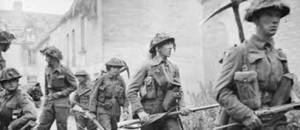This was the real turning point in the Second World War, although it came much later than it should have done, due mainly to inappropriate weather conditions for a sea-based landing. The British Isles were undergoing one of those violent climate changes to which we are now more accustomed. It was summertime, but Britain’s east coast ports and resorts were lashed by wind and near freezing rain. The sea between British and French coasts choppy and crossed with currents. The cold at sea was appalling, as if the breezes were blowing directly from the Russian steppes. Only the tempers of the soldiers, sailors and airmen waiting, waiting, and still waiting in the barracks, manor houses and homes to which they had been invited by English people in the villages and towns of the south-east, were hot and getting hotter.
On the other side of the Channel the Germans maintained their many forces in and around the ports of the Pas de Calais, where every officer expected the umavoidable landings to be directed. Very few senior officers, and even Hitler himself, thought otherwise. Field Marshall Rommel had been one of these; he had advised building and maintaining defences all alongt the coast of Normandy and in parts of Brittany, but he would soon be dead, forced to take poison after the failure of the July Conspiracy against Hitler. Gerd von Rundstedt was another, but Hitler continuously and mistakenly kept firing this clever old man from his position as Commander-in-Chief of land forces in France, replacing him with nonentities.
More than two million men crossed the Channel on and after D-Day. The British got off their three beaches quite quickly, and began abosorbing German pressure around the city of Caen. The enemy had seven of eight divisions deployed there, and British progress was slow. The Americans took longer to get off their heavily defended beaches of ‘Utah’ and ‘Omaha’ (where Rommel had correctly surmised the invasion would be centred, and had had time to construct defences and emplace artillery). But at last the US forces got through and had captured Cherbourg, Normandy’s principal port by June 20th. Sadly, the town was so badly damaged in the assault that its uses as a port were lost, at least until the end of July that year.
Clearing the Cotentin Peninsula, Montgomery and his army group took Caen on 8 July. On 25 July Patton’s tanks surged through Avranches, securing most of Brittany, before turning eastwards towards the Loire river. Hitler now had to decide whether to withdraw from Normandy, or counter attack. Typically, he chose the more Wagnerian option and attacked, attempting to seal off the Avranches bottleneck. He failed on 7th August – the first day. As the Germany armies moved west, the Americans were advancing east, below the German assault! As the British and Commonwealth forces turned south towards Falaise, the Americans turned north towards Argentan. The ‘Failaise Gap’ was closed by 19 August. No less than twelve Germany divisions found themselves in a tiny area, maybe seven miles square. They were bombarded by artillery, and bombed and strafed from the air. Ten thousand German troops died, and 50,000 were captured (but 30,000 escaped too). The Allies made their projected landing in the south of France, which, as the Germans were in retreat, proved unnecessary.
German soldiers were withdrawn from France, Belgium and Luxembourg, but it was too late: on 24 August US and French troops entered Paris, with a triumphant General de Gaulle leading them (q.v.). The world learned that Cholitz, German commander in Paris, had directly disobeyed Hitler’s order, which was to destroy the city*. Paris was virtually undamaged, and Hitler and his followers were furious.
On D-Day the Allies had landed nearly two million men in France, and had inflicted half a million casualties, though they lost half of this number in the invasion. France was ‘freed’ from German occupation, and history’s largest invasion force marched on (they thought) to take Berlin and end the War. They were wrong, but that is a story told elsewhere (q.v.).
* See the movie Is Paris Burning (1965)











Leave A Comment